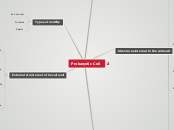Prokaryotic Cell
Characteristics
Smaller in size
No membrane bound organelles
Cell division by binary fission
Structures internal to the cell wall
Plasma membrane
Mechanical boundary of cell, nutrient
and waste transport
Location for metabolic processes
Detection of environmental cues
for chemotaxis
Function
Selectively permeable barrier
Synthesis cell wall components
Assists in DNA replications
Carries on respiration
Captures energy as ATP
Destruction
Disinfectants - alcohols and quatenary ammonium compounds
Cause leakage of intracellular contents
Plasmolysis: cells shrink
Lysis: cells burst
Uptake of Nutrients - Getting Through Barriers
Macroelements (macronutrients)
Micronutrients (trace elements)
Some unique substances may required
The movement of materials across membranes
Passive processes
Simple diffusion
Facilitated diffusion
Osmosis
Active process
Active transport
Group translocation
Cytoplasm
substance of the cell within plasma membrane
consist of 80% water and
primarily contain protein,
carbohydrates and lipids
Intracytoplasmic membranes
Plasma membrane infoldings
Anammoxosome in Planctomycetes
Nuclear area or nucleoid
contain genetic information
Plasmid
Ribosomes
sites for protein synthesis
RNA or rRNA
Inclusions
Storage of carbon, phosphate and
other substance
Types of inclusions
Metachromatic granules
Large inclusions
Stain red with certain blue dyes such as methylene blue
Polysaccharide granules
Consists glycogen and starch
Diffentiate by using iodine
glycogen granules: reddish brown
starch granules: blue
Lipid inclusios
Storage material -polymer poly-beta-hydroxybutyric acid
Sulfur granules
Energy reserve
Derive energy
oxidising sulfur
sulfur-containing compounds
Thiobacillus - sulfur bact.
Carboxysomes
Contain the enzyme ribulose 1,5-diphosphate carboxylase
Used for co2 fixation during photosynthesis
Magnetosomes
Iron oxide (Fe3O4) that act like magnet
Gas vesicles
Endospore
Cell wall
Responsible for the shape of the cell
Prevent bacterial cells from rupturing due to the change in pressure
The point of anchorage flagella
May contain antigen if the bacteria is infectious
Types of cell wall
Gram +ve
Gram -ve
Types of motility
Run or swim
Tumbles
Swarm
External structures to the cell wall
Glycocalyx
Attachment to surface
Protect against dehydration
Inhibit movement of nutrients out of cells
Source of nutrients
Flagella
Long filamentous appendages for motility
Axial filaments
Present in spirochetes
Known as endoflagella
For corkscrew movement
Fimbriae
Occur at poles or distributed
over the entire surface
Function as attachment
